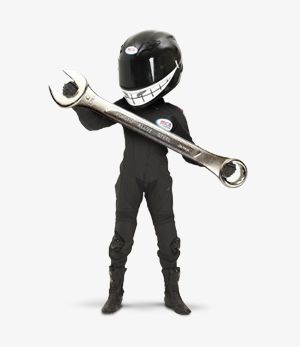Big Ed's Workshop - Fork Seals

Keeping a motorcycle maintained is important not only for the health of the machine but also for your own safety. Through this Bikers Guide I'm going to give you some top tips for doing work yourself, not only to give you a better understanding of your bike, but also to save you some pennies!
Why it's important:
Fork seals on a motorbike do pretty much what they say on the tin. They keep oil inside the forks. Being made of rubber they are prone to damage because corrosion gets in behind them on the inner fork and scratches the rubber making it no longer airtight.
You can stop this from happening by keeping your inner forks clean, regularly rubbing them down and keeping an eye on corrosion levels.
Fork seals often come up on MOT as it is hard to spot sometimes if they've gone or are going. Tell tale signs will be oil on the inner fork or in bad cases dripping down onto your wheel and brakes. This is where it can become dangerous so it's always worth giving them a look.
Let's get to work:
Step 1: Get your front wheel up in the air, either through use of a centre stand or some other paddock stand. Remove the front wheel. Remove the calipers from fork legs however, many there may be. That should be most components removed from the forks, if there's anything else remove that too. Then undo the bolts on the top yoke and bottom yoke, usually where the forks are held, then remove the fork in a downwards motion.
Step 2: So now you have your fork and are ready to remove the oil. Place the outer fork in a vice; you can get soft protectors to go on your vice to stop it damaging delicate paintwork. Then you will need an impact screwdriver with Allen attachment to remove a bolt right at the bottom of the outer fork. It is an anchor bolt that holds the inner and outer together. Compress the fork manually and buzz out the bolt taking care as oil will come out! Have a container ready to catch it. Remove the fork from the vice and push out the rest of the oil into the container.
Step 3: Place the outer fork back into the vice and remove any dust covers or metal clips that hold the seal in place. Now take hold of the inner fork and yank at it as hard as you can. A sort of hammer motion works best. Basically you are using the inner fork to drive out the seal. Eventually the seal will pop out and you can inspect the damage. Make sure you keep hold of everything that comes out and the order they go in, washers etc.
Step 4: Now you will have two complete parts, an inner and outer fork. Use this time to rub down your inner fork with wet and dry removing any blemishes. Put the inner fork back inside the outer with all the other washers etc attached and put the outer back in the vice. Take your anchor bolt and put it back into the hole at the bottom of the outer fork. This part can be tricky, I find if you apply pressure to the inner fork as you buzz up the bolt it usually goes on. Now slide your new seal (make sure it's the right size, it tells you on the old seal), it will slide until it reaches the outer fork and then you will have to hammer it in. Be very careful not to damage the seal here. I find if you've got a ring shaped piece of metal that fits over the inner but under the outer fork it makes hammering in a lot easier. Once the seal is in it's proper position, replace the clip and dust cover if your bike has them.
Step 5: Now your fork is complete again it just needs oil. Open the top of the fork and fill with the correct amount of fork oil. You should be able to find out how much from your owners manual. Replace the top of the fork and reattach to the bike reversing the method for getting them off.
And that's all there is to it! I find sometimes its better to do both seals at once as the wheel is already off though you might have one side prone to problems so concentrate on that only. I leave it to you!
Ride safe all and happy maintaining!
08.03.13 - Big Ed





